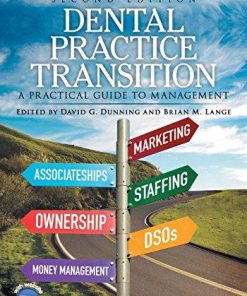(EBOOK PDF)Management A Practical Introduction 7th edition by Angelo Kinicki, Denise Breaux Soignet, Chad Hartnell 9781264263738 1264263732 full chapters
$50.00 Original price was: $50.00.$25.00Current price is: $25.00.
Management A Practical Introduction 7th edition by Angelo Kinicki, Denise Breaux Soignet, Chad Hartnell – Ebook PDF Instant Download/Delivery: 9781264263738, 1264263732
Full download Management A Practical Introduction 7th edition after payment

Product details:
• ISBN 10:1264263732
• ISBN 13:9781264263738
• Author:Angelo Kinicki, Denise Breaux Soignet, Chad Hartnell
Management: A Practical Introduction: 2024 Release
Management: A Practical Introduction, 10e, empowers students to develop their career readiness. Developed to help students read and learn management with a purpose, it takes a student-centered approach. This is the only product that uniquely integrates a strategic career readiness theme throughout to address employers? concerns about students graduating without being career-ready. It continues to engage students through practical and relevant application of theory, current examples, imaginative writing, and resources that work. Their unique Teaching Resource Manual offers numerous suggestions for creating an active, discussion-oriented, experiential classroom with lesson plans to assist with course preparation. The revision expands its strategic career readiness theme, integrates new coverage on creating shared value and sustainable development, increases the examples to be inclusive and representative of our diverse body of today?s managers and employees, and overhauled the TRM with detailed lesson plans to assist with course preparation for both in-person and online classes.
Management A Practical Introduction 7th Table of contents:
Cover Page
Title Page
Copyright Page
Brief Contents
About The Authors
Dedication
New to the 2024 Release
Walkthrough Preface
Focus on Career Readiness
Student-Centered Approach to Learning
Imaginative Writing for Readability and Reinforcement
Extended Emphasis on Practicality
Resources That Work
Connect
Acknowledgments
Contents
Chapter DEI: Diversity, Equity, and Inclusion (DE&I)
Chapter DEI: Introduction
DEI.1 Managing DE&I: The What, How, and Why
Diversity (The What)
Equity (The How)
Inclusion (The Why)
DEI.2 The Evolution of DE&I in Organizations
A History of Protections
A History of Changes
A History of Tensions
DEI.3 Challenges of Effective DE&I Management
Person Factors
Environmental Factors
DEI.4 Effective DE&I Management Practices
Managerial Practices
Organizational Practices
DEI.5 Career Corner
Practice Seeing Things from Others’ Perspectives
Work on Being an Ally
Accept That You Won’t Be Perfect (Be a Good-ish Person)
Key Terms Used in This Chapter
Chapter 1: The Exceptional Manager: What You Do, How You Do It
Chapter 1: Introduction
The Exceptional Manager What You Do, How You Do It
1.1 Management: What It Is, What Its Benefits Are
The Rise of a Leader
Key to Career Growth: “Doing Things I’ve Never Done Before”
The Art of Management Defined
Why Organizations Value Managers: The Multiplier Effect
What Are the Rewards of Studying and Practicing Management?
1.2 What Managers Do: The Four Principal Functions
Planning: Discussed in Part 3 of This Book
Organizing: Discussed in Part 4 of This Book
Leading: Discussed in Part 5 of This Book
Controlling: Discussed in Part 6 of This Book
1.3 Pyramid Power: Levels and Areas of Management
The Traditional Management Pyramid: Levels and Areas
Four Levels of Management
Areas of Management: Functional Managers versus General Managers
Managers for Three Types of Organizations: For-Profit, Nonprofit, Mutual-Benefit
Different Organizations, Different Management?
1.4 Roles Managers Must Play Successfully
The Manager’s Roles: How Do Managers Spend Their Time?
Three Types of Managerial Roles: Interpersonal, Informational, and Decisional
1.5 The Skills Exceptional Managers Need
1. Technical Skills—The Ability to Perform a Specific Job
2. Conceptual Skills—The Ability to Think Analytically
3. Human Skills—“Soft Skills,” the Ability to Interact Well with People
The Most Valued Traits in Managers
1.6 Seven Challenges to Being an Exceptional Manager
Challenge #1: Managing for Competitive Advantage—Staying Ahead of Rivals
Challenge #2: Managing for Technological Advances—Dealing with the “New Normal”
Challenge #3: Managing for Inclusion and Diversity—The Future Won’t Resemble the Past
Challenge #4: Managing for Globalization—The Expanding Management Universe
Challenge #5: Managing for Ethical Standards
Challenge #6: Managing for Sustainable Development —The Business of Green
Challenge #7: Managing for Happiness and Meaningfulness
How Strong Is Your Motivation to Be a Manager? The First Self-Assessment
1.7 Building Your Career Readiness
A Model of Career Readiness
Developing Career Readiness
Let Us Help
1.8 Career Corner: Managing Your Career Readiness
A Process for Developing Career Readiness
Make It a Habit
Key Terms Used in This Chapter
Key Points
Chapter 2: Management Theory: Essential Background for the Successful Manager
Chapter 2: Introduction
2.1 Evolving Viewpoints: How We Got to Today’s Management Outlook
Creating Modern Management: The Handbook of Peter Drucker
Six Practical Reasons for Studying This Chapter
The Progression of Management Viewpoints
2.2 Classical Viewpoint: Scientific and Administrative Management
Scientific Management: Pioneered by Taylor and the Gilbreths
Administrative Management: Pioneered by Spaulding, Fayol, and Weber
The Problem with the Classical Viewpoint: Too Mechanistic
2.3 Behavioral Viewpoint: Behaviorism, Human Relations, and Behavioral Science
Early Behaviorism: Pioneered by Follett and Mayo
The Human Relations Movement: Pioneered by Maslow and McGregor
The Behavioral Science Approach
2.4 Quantitative Viewpoints: Operations Management and Evidence-Based Management
Operations Management: Being More Effective
Evidence-Based Management: Facing Hard Facts, Rejecting Nonsense
2.5 Systems Viewpoint
The Systems Viewpoint
2.6 Contingency Viewpoint
2.7 Contemporary Approaches: The Learning Organization, High-Performance Work Practices, and Shared Value and Sustainable Development
The Learning Organization: Sharing Knowledge and Modifying Behavior
High-Performance Work Practices
Shared Value and Sustainable Development: Going beyond Profits
2.8 Career Corner: Managing Your Career Readiness
Key Terms Used in This Chapter
Key Points
Boeing Continuing Case
Chapter 3: The Manager’s Changing Work Environment and Ethical Responsibilities: Doing the Right Thing
Chapter 3: Introduction
The Manager’s Changing Work Environment and Ethical Responsibilities Doing the Right Thing
3.1 The Goals of Business: More Than Making Money
The Triple Bottom Line: People, Planet, and Profit
Younger Workers’ Search for Meaning
3.2 The Community of Stakeholders inside the Organization
Internal and External Stakeholders
Internal Stakeholders
3.3 The Community of Stakeholders Outside the Organization
The Task Environment
The General Environment
3.4 The Ethical Responsibilities Required of You as a Manager
Defining Ethics and Values
Four Approaches to Resolving Ethical Dilemmas
White-Collar Crime, SarbOx, and Ethical Training
How Organizations Can Promote Ethics
3.5 The Social Responsibilities Required of You as a Manager
Corporate Social Responsibility: The Top of the Pyramid
Is Social Responsibility Worthwhile? Opposing and Supporting Viewpoints
One Type of Social Responsibility: Climate Change, Sustainable Development, and Natural Capital
Another Type of Social Responsibility: Undertaking Philanthropy, “Not Dying Rich”
Does Being Good Pay Off?
3.6 Corporate Governance
Corporate Governance and Ethics
Corporate Governance and Social Responsibility
3.7 Career Corner: Managing Your Career Readiness
Focus on the Greater Good and on Being More Ethical
Become an Ethical Consumer
Key Terms Used in This Chapter
Key Points
Learning Module 1: Shared Value and Sustainable Development
Learning Module 1: Introduction
A New Way to Think about Leading and Managing
1.1 From Corporate Social Responsibility to Creating Shared Value
Traditional CSR
Creating Shared Value
A Model of Shared Value Creation
How CSR and CSV Are Fundamentally Different
1.2 The Roles of Various Stakeholders in CSV
Global Collaboration: The Role of the United Nations
The Role of Businesses, Big and Small
The Role of Entrepreneurs
The Role of Business Schools
1.3 Progress, Challenges, and Recommendations for CSV
Current Progress and Challenges in Shared Value and Sustainable Development
Recommendations for Transitioning to a Shared-Value Mindset
Key Terms Used in This Learning Module
Key Points
Chapter 4: Global Management: Managing across Borders
Chapter 4: Introduction
4.1 Globalization: The Collapse of Time and Distance
Competition and Globalization: Who Will Be No. 1 Tomorrow?
The Rise of the “Global Village” and Electronic Commerce
One Big World Market: The Global Economy
4.2 You and International Management
Why Learn about International Management?
The Successful International Manager: Geocentric, Not Ethnocentric or Polycentric
4.3 Why and How Companies Expand Internationally
Why Companies Expand Internationally
How Companies Expand Internationally
4.4 The World of Free Trade: Regional Economic Cooperation and Competition
Barriers to International Trade
Organizations Promoting International Trade
Major Trading Blocs
Most Favored Nation Trading Status
Exchange Rates
The BRICS Countries: Important International Competitors
4.5 The Value of Understanding Cultural Differences
The Importance of National Culture
Cultural Dimensions: The Hofstede and GLOBE Project Models
Other Cultural Variations: Language, Interpersonal Space, Communication, Time Orientation, Religion, and Law and Political Stability
U.S. Managers on Foreign Assignments: Why Do They Fail?
4.6 Career Corner: Managing Your Career Readiness
1. Listen and Observe
2. Become Aware of the Context
3. Choose Something Basic
Key Terms Used in This Chapter
Key Points
Boeing Continuing Case
Chapter 5: Planning: The Foundation of Successful Management
Chapter 5: Introduction
Planning The Foundation of Successful Management
5.1 Planning and Strategy
Planning, Strategy, and Strategic Management
Why Planning and Strategic Management Are Important
5.2 Fundamentals of Planning
Mission, Vision, and Values Statements
Three Types of Planning for Three Levels of Management: Strategic, Tactical, and Operational
5.3 Goals and Plans
Long-Term and Short-Term Goals
The Operating Plan and Action Plan
Plans Are Great, But . . .
5.4 Promoting Consistencies in Goals: SMART Goals, Management by Objectives, and Goal Cascading
SMART Goals
Management by Objectives: The Four-Step Process for Motivating Employees
Cascading Goals: Making Lower-Level Goals Align with Top Goals
5.5 The Planning/Control Cycle
5.6 Career Corner: Managing Your Career Readiness
Becoming More Proactive
Keeping an Open Mind and Suspending Judgment
Key Terms Used in This Chapter
Key Points
Chapter 6: Strategic Management: How Exceptional Managers Realize a Grand Design
Chapter 6: Introduction
6.1 Strategic Positioning and Levels of Strategy
Strategic Positioning and Its Principles
Levels of Strategy
Does Strategic Management Work for Small as Well as Large Firms?
6.2 The Strategic-Management Process
The Five Steps of the Strategic-Management Process
6.3 Assessing the Current Reality
SWOT Analysis
Using VRIO to Assess Competitive Potential: Value, Rarity, Imitability, and Organization
Forecasting: Predicting the Future
Benchmarking: Comparing with the Best
6.4 Establishing Corporate-Level Strategy
Three Overall Types of Corporate Strategy
The BCG Matrix
Diversification Strategy
6.5 Establishing Business-Level Strategy
Porter’s Five Competitive Forces
Porter’s Four Competitive Strategies
An Executive’s Approach toward Strategy Development
6.6 Strategic Implementation: Creating, Executing, and Controlling Functional-Level Strategies
Strategic Implementation: Creating, Executing, and Controlling Functional-Level Strategies
Execution: Getting Things Done
The Three Core Processes of Business: People, Strategy, and Operations
Execution Roadblocks
Maintaining Strategic Control
6.7 Career Corner: Managing Your Career Readiness
Why Is Strategic Thinking Important to New Graduates?
Developing Strategic Thinking
Key Terms Used in This Chapter
Key Points
Learning Module 2: Entrepreneurship
Learning Module 2: Introduction
2.1 Entrepreneurship: Its Foundations and Importance
Entrepreneurship: It’s Not the Same as Self-Employment
Social Entrepreneurship
Characteristics of Entrepreneurs
Entrepreneurship Matters across the Globe
2.2 Starting a Business
Businesses Start with an Idea
Franchising: Building on Someone Else’s Idea
Writing the Business Plan
Choosing a Legal Structure
Obtaining Financing
Creating the “Right” Organizational Culture and Design
Why Entrepreneurial Ventures Fail
Key Terms Used in This Learning Module
Key Points
Chapter 7: Individual and Group Decision Making: How Managers Make Things Happen
Chapter 7: Introduction
7.1 Two Kinds of Decision Making: Rational and Nonrational
Rational Decision Making: Managers Should Make Logical and Optimal Decisions
Stage 1: Identify the Problem or Opportunity—Determining the Actual versus the Desirable
Stage 2: Think Up Alternative Solutions—Both the Obvious and the Creative
Stage 3: Evaluate Alternatives and Select a Solution—Ethics, Feasibility, and Effectiveness
Stage 4: Implement and Evaluate the Solution Chosen
What’s Wrong with the Rational Model?
Nonrational Decision Making: Managers Find It Difficult to Make Optimal Decisions
7.2 Making Ethical Decisions
The Dismal Record of Business Ethics
Road Map to Ethical Decision Making: A Decision Tree
7.3 Evidence-Based Decision Making and Data Analytics
Evidence-Based Decision Making
In Praise of Data Analytics
Big Data: What It Is, How It’s Used
7.4 Artificial Intelligence Is a Powerful Decision-Making Resource
Types of AI
AI’s Benefits
AI’s Drawbacks
7.5 Four General Decision-Making Styles
Value Orientation and Tolerance for Ambiguity
1. The Directive Style: Action-Oriented Decision Makers Who Focus on Facts
2. The Analytical Style: Careful Decision Makers Who Like Lots of Information and Alternative Choices
3. The Conceptual Style: Decision Makers Who Rely on Intuition and Have a Long-Term Perspective
4. The Behavioral Style: The Most People-Oriented Decision Makers
Which Style Do You Have?
7.6 Decision-Making Biases
Ten Common Decision-Making Biases: Rules of Thumb, or “Heuristics”
7.7 Group Decision Making: How to Work with Others
Advantages and Disadvantages of Group Decision Making
Groupthink
Characteristics of Group Decision Making
Group Problem-Solving Techniques: Reaching for Consensus
More Group Problem-Solving Techniques
7.8 Career Corner: Managing Your Career Readiness
Improving Your Critical Thinking and Problem-Solving Skills
Reflect on Past Decisions
Establish a Decision Methodology
Demonstrating These Competencies during a Job Interview
Key Terms Used in This Chapter
Key Points
Boeing Continuing Case
Chapter 8: Organizational Culture and Structure: Drivers of Strategic Implementation
Chapter 8: Introduction
Organizational Culture and Structure Drivers of Strategic Implementation
8.1 Aligning Culture, Structure, and Human Resource (HR) Practices to Support Strategy
How an Organization’s Culture, Structure, and HR Practices Support Strategic Implementation
8.2 What Kind of Organizational Culture Will You Be Operating In?
The Three Levels of Organizational Culture
How Employees Learn Culture: Symbols, Stories, Heroes, Rites and Rituals, and Organizational Socialization
Four Types of Organizational Culture: Clan, Adhocracy, Market, and Hierarchy
The Importance of Culture
Preparing to Assess Person–Organization Fit before a Job Interview
8.3 The Process of Culture Change
1. Formal Statements
2. Slogans and Sayings
3. Rites and Rituals
4. Stories, Legends, and Myths
5. Leader Reactions to Crises
6. Role Modeling, Training, and Coaching
7. Physical Design
8. Rewards, Titles, Promotions, and Bonuses
9. Organizational Goals and Performance Criteria
10. Measurable and Controllable Activities
11. Organizational Structure
12. Organizational Systems and Procedures
Using Multiple Mechanisms to Drive Culture Change
Don’t Forget about Person–Organization Fit
8.4 The Major Features of an Organization
Major Features of Organizations: Four Proposed by Edgar Schein
Major Features of Organizations: Three More That Most Authorities Agree On
The Organization Chart
8.5 Eight Types of Organizational Structure
1. Traditional Designs: Simple, Functional, Divisional, and Matrix Structures
2. The Horizontal Design: Eliminating Functional Barriers to Solve Problems
3. Designs That Open Boundaries between Organizations: Hollow, Modular, and Virtual Structures
8.6 Career Corner: Managing Your Career Readiness
Understanding the Business and Where You “Fit” In
Becoming More Adaptable
Key Terms Used in This Chapter
Key Points
Chapter 9: Human Resource Management: Getting the Right People for Managerial Success
Chapter 9: Introduction
9.1 Strategic Human Resource Management
Human Resource Management: Managing an Organization’s Most Important Resource
Internal and External HR Fit Promote Strategic HR Management
The Role of Human and Social Capital
What Is the Best Approach to Strategic Human Resource Management?
9.2 Recruitment and Selection: Putting the Right People into the Right Jobs
Recruitment: How to Attract Qualified Applicants
Selection: How to Choose the Best Person for the Job
9.3 Managing an Effective Workforce: Compensation and Benefits
Wages or Salaries
Incentives
Benefits
9.4 Onboarding and Learning and Development
Onboarding: Helping Newcomers Learn the Ropes
Learning and Development: Helping People Perform Better
9.5 Performance Management
Performance Management in Human Resources
Performance Appraisals: Are They Worthwhile?
Two Kinds of Performance Appraisal: Objective and Subjective
Who Should Make Performance Appraisals?
Effective Performance Feedback
9.6 Managing Promotions, Transfers, Disciplining, and Dismissals
Promotion: Moving Upward
Transfer: Moving Sideways
Disciplining and Demotion: The Threat of Moving Downward
Dismissal: Moving Out of the Organization
9.7 The Legal Requirements of Human Resource Management
1. Labor Relations
2. Compensation and Benefits
3. Health and Safety
4. Equal Employment Opportunity
Workplace Discrimination, Affirmative Action, Sexual Harassment, and Bullying
9.8 Labor–Management Issues
How Workers Organize
How Unions and Management Negotiate a Contract
The Issues Unions and Management Negotiate About
Settling Labor–Management Disputes
9.9 Career Corner: Managing Your Career Readiness
Becoming a Better Receiver
Key Terms Used in This Chapter
Key Points
Chapter 10: Organizational Change and Innovation: Lifelong Challenges for the Exceptional Manager
Chapter 10: Introduction
10.1 The Nature of Change in Organizations
Fundamental Change: What Will You Be Called On to Deal With?
Two Types of Change: Reactive and Proactive
The Forces for Change Outside and Inside the Organization
10.2 Forms and Models of Change
Three Forms of Change: From Least Threatening to Most Threatening
Lewin’s Change Model: Unfreezing, Changing, and Refreezing
A Systems Approach to Change
10.3 Organizational Development: What It Is, What It Can Do
What Can OD Be Used For?
How OD Works
The Effectiveness of OD
10.4 Organizational Innovation
Approaches to Innovation
An Innovation System: The Supporting Forces for Innovation
10.5 The Threat of Change: Managing Employee Fear and Resistance
The Causes of Resistance to Change
Ten Reasons Employees Resist Change
10.6 Career Corner: Managing Your Career Readiness
Applying Self-Affirmation Theory
Practicing Self-Compassion
Key Terms Used in This Chapter
Key Points
Boeing Continuing Case
Chapter 11: Managing Individual Differences and Behavior: Supervising People as People
Chapter 11: Introduction
Managing Individual Differences and Behavior Supervising People as People
11.1 Personality and Individual Behavior
The Big Five Personality Dimensions
Core Self-Evaluations
Emotional Intelligence: Understanding Your Emotions and the Emotions of Others
11.2 Values, Attitudes, and Behavior
Organizational Behavior: Trying to Explain and Predict Workplace Behavior
Values: What Are Your Consistent Beliefs and Feelings about All Things?
Attitudes: What Are Your Consistent Beliefs and Feelings about Specific Things?
Behavior: How Values and Attitudes Affect People’s Actions and Judgments
11.3 Perception and Individual Behavior
The Four Steps in the Perceptual Process
Five Distortions in Perception
The Self-Fulfilling Prophecy, or Pygmalion Effect
11.4 Work-Related Attitudes and Behaviors Managers Need to Deal With
1. Employee Engagement: How Connected Are You to Your Work?
2. Job Satisfaction: How Much Do You Like or Dislike Your Job?
3. Organizational Commitment: How Much Do You Identify with Your Organization?
Important Workplace Behaviors
11.5 Understanding Stress and Individual Behavior
The Toll of Workplace Stress
How Does Stress Work?
The Sources of Job-Related Stress
Reducing Stressors in the Organization
11.6 Career Corner: Managing Your Career Readiness
Fostering a Positive Approach
Self-Managing Your Emotions
Key Terms Used in This Chapter
Key Points
Chapter 12: Motivating Employees: Achieving Superior Performance in the Workplace
Chapter 12: Introduction
12.1 Motivating for Performance
Motivation: What It Is, Why It’s Important
The Four Major Perspectives on Motivation: An Overview
12.2 Content Perspectives on Employee Motivation
Maslow’s Hierarchy of Needs Theory: Five Levels
McClelland’s Acquired Needs Theory: Achievement, Affiliation, and Power
Deci and Ryan’s Self-Determination Theory: Competence, Autonomy, and Relatedness
Herzberg’s Two-Factor Theory: From Dissatisfying Factors to Satisfying Factors
12.3 Process Perspectives on Employee Motivation
Equity/Justice Theory: How Fairly Do You Think You’re Being Treated in Relation to Others?
Expectancy Theory: How Much Do You Want and How Likely Are You to Get It?
Goal-Setting Theory: Objectives Should Be Specific and Challenging but Achievable
12.4 Job Design Perspectives on Motivation
Fitting People to Jobs
Fitting Jobs to People
The Job Characteristics Model: Five Job Attributes for Better Work Outcomes
Relational Job Design
12.5 Reinforcement Perspectives on Motivation
The Four Types of Behavior Modification: Positive Reinforcement, Negative Reinforcement, Extinction, and Punishment
Using Behavior Modification to Motivate Employees
12.6 Using Compensation, Nonmonetary Incentives, and Other Rewards to Motivate: In Search of the Positive Work Environment
Is Money the Best Motivator?
Motivation and Compensation
Nonmonetary Ways of Motivating Employees
12.7 Career Corner: Managing Your Career Readiness
The Self-Management Process
Recharging
Key Terms Used in This Chapter
Key Points
Chapter 13: Groups and Teams: Increasing Cooperation, Reducing Conflict
Chapter 13: Introduction
13.1 Groups versus Teams
Groups and Teams: How Do They Differ?
Formal versus Informal Groups
Types of Teams
An Organizing Framework
13.2 Stages of Group and Team Development
Tuckman’s Five-Stage Model
Punctuated Equilibrium
13.3 Building Effective Teams
1. Collaboration—the Foundation of Teamwork
2. Trust: “We Need to Have Reciprocal Faith in Each Other”
3. Performance Goals and Feedback
4. Motivation through Mutual Accountability and Interdependence
5. Team Composition
6. Roles: How Team Members Are Expected to Behave
7. Norms: Unwritten Rules for Team Members
Putting It All Together
13.4 Managing Conflict
The Nature of Conflict: Disagreement Is Normal
Can Too Little or Too Much Conflict Affect Performance?
Four Kinds of Conflict: Personality, Envy, Intergroup, and Cross-Cultural
How to Stimulate Constructive Conflict
Career Readiness Competencies to Help You to Better Handle Conflict
Dealing with Disagreements: Five Conflict-Handling Styles
13.5 Career Corner: Managing Your Career Readiness
Become a More Effective Team Member
Become a More Effective Collaborator
13.6 Managing Team Dysfunction
The 5 Dysfunctions of a Team
Recommendations to Solve the 5 Team Dysfunctions
Key Terms Used in This Chapter
Key Points
Chapter 14: Power, Influence, and Leadership: From Becoming a Manager to Becoming a Leader
Chapter 14: Introduction
14.1 The Nature of Leadership: The Role of Power and Influence
What Is the Difference between Leading and Managing?
Managerial Leadership: Can You Be Both a Manager and a Leader?
Six Sources of Power
Common Influence Tactics
Outcomes of Influence Tactics
14.2 Trait Approaches: Do Leaders Have Distinctive Traits and Personal Characteristics?
Positive Task-Oriented Traits and Positive/Negative Interpersonal Attributes
What Do We Know about Gender and Leadership?
Are Knowledge and Skills Important?
So What Do We Know about Leadership Traits?
14.3 Behavioral Approaches: Do Leaders Show Distinctive Patterns of Behavior?
Task-Oriented Leader Behaviors
The Focus of Task-Oriented Leadership: “Here’s What We Do to Get the Job Done”
Relationship-Oriented Leader Behavior
The Focus of Relationship-Oriented Leadership: “The Concerns and Needs of My Employees Are Highly Important”
So What Do We Know about the Behavioral Approaches?
14.4 Situational Approaches: Does Leadership Vary with the Situation?
1. The Contingency Leadership Model: Fiedler’s Approach
2. The Path–Goal Leadership Model: House’s Approach
So What Do We Know about the Situational Approaches?
14.5 The Full-Range Model: Using Transactional and Transformational Leadership
Transactional and Transformational Leadership
The Best Leaders Are Both Transactional and Transformational
Four Key Behaviors of Transformational Leaders
So What Do We Know about Transformational Leadership?
14.6 Contemporary Perspectives and Concepts
Leader–Member Exchange Leadership: Having Different Relationships with Different Subordinates
Servant Leadership
The Power of Humility
Empowering Leadership
Ethical Leadership
Followers: What Do They Want, How Can They Help?
Abusive Supervision
14.7 Career Corner: Managing Your Career Readiness
Becoming More Self-Aware
Key Terms Used in This Chapter
Key Points
Chapter 15: Interpersonal and Organizational Communication: Mastering the Exchange of Information
Chapter 15: Introduction
15.1 The Communication Process: What It Is, How It Works
Communication Defined: The Transfer of Information and Understanding
How the Communication Process Works
Selecting the Right Medium for Effective Communication
15.2 How Managers Fit into the Communication Process
Formal Communication Channels: Up, Down, Sideways, and Outward
Informal Communication Channels
15.3 Barriers to Communication
1. Physical Barriers: Sound, Time, Space
2. Personal Barriers: Individual Attributes That Hinder Communication
3. Cross-Cultural Barriers
4. Nonverbal Communication: How Unwritten and Unspoken Messages May Mislead
5. Gender Differences
15.4 Social Media and Management
The Use of Social Media Has Changed the Fabric of Our Lives
Social Media and Managerial and Organizational Effectiveness
Downsides of Social Media
Managerial Considerations in Creating Social Media Policies
15.5 Improving Communication Effectiveness
Nondefensive Communication
Using Empathy
Being an Effective Listener
Being an Effective Writer
Being an Effective Speaker
15.6 Career Corner: Managing Your Career Readiness
Improve Your Face-to-Face Networking Skills
Key Terms Used in This Chapter
Key Points
Boeing Continuing Case
Chapter 16: Control Systems and Quality Management: Techniques for Enhancing Organizational Effectiveness
Chapter 16: Introduction
Control Systems and Quality Management Techniques for Enhancing Organizational Effectiveness
16.1 Control: When Managers Monitor Performance
16.2 The Control Process and Types of Control
Steps in the Control Process
Types of Controls
16.3 What Should Managers Control?
The Balanced Scorecard: A Comprehensive Approach to Managerial Control
Financial Perspective: “What Does Success Look Like to Our Shareholders?”
Customer Perspective: “How Do We Appear to Our Customers?”
Internal Business Perspective: “What Must We Do Extremely Well?”
Innovation and Learning Perspective: “Are We Equipped for Continued Value and Improvement?”
Strategy Mapping: Visual Representation of the Path to Organizational Effectiveness
16.4 Total Quality Management
Quality Control and Quality Assurance
Deming Management: The Contributions of W. Edwards Deming to Improved Quality
Core TQM Principles: Deliver Customer Value and Strive for Continuous Improvement
Applying TQM to Services
Some TQM Tools, Techniques, and Standards
Takeaways from TQM Research
16.5 Contemporary Control Issues
Using Artificial Intelligence to Control
Employee Tracking and Monitoring
16.6 Career Corner: Managing Your Career Readiness
The Control Process and Career Management
Continuous Self-Improvement
Life Lessons for Your Career Management
Key Terms Used in This Chapter
Key Points
Boeing Continuing Case
Appendix: The Project Planner’s Toolkit: Flowcharts, Gantt Charts, and Break-Even Analysis
Appendix: The Project Planner’s Toolkit
Tool #1: Flowcharts—for Showing Event Sequences and Alternate Decision Scenarios
Tool #2: Gantt Charts—Visual Time Schedules for Work Tasks
Tool #3: Break-Even Analysis—How Many Items Must You Sell to Turn a Profit?
Chapter Notes
Chapter Notes
Name Index
Name Index
Organization Index
Organization Index
Glossary/Subject Index
Glossary/Subject Index
Accessibility Content: Text Alternatives for Images
The Cover Page of Management, A Practical Introduction Text Alternative (FM)
A Page with Four Sections Shows the McGraw Hill Logo Text Alternative (FM)
A Page Shows the Text, Support at Every Stamp Text Alternative (FM)
Figure DEI.1 Text Alternative (Chapter DEI 1)
A Notice Reads, Racism and Discrimination Text Alternative (Chapter DEI 1)
A Group of Three People Stand Atop Text Alternative (Chapter DEI 1)
Figure DEI.2 Text Alternative (Chapter DEI 1)
Figure 1.1 Text Alternative (Chapter 1)
Figure 1.2 Text Alternative (Chapter 1)
Figure 1.3 Text Alternative (Chapter 1)
Figure 1.4 Text Alternative (Chapter 1)
Figure 1.5 Text Alternative (Chapter 1)
Figure 2.1 Text Alternative (Chapter 2)
Two Displays, the First One Shows Seven People in a Virtual Meeting Text Alternative (Chapter 2)
Figure 2.2 Text Alternative (Chapter 2)
Figure 3.1 Text Alternative (Chapter 3)
Figure 3.2 Text Alternative (Chapter 3)
Figure 3.3 Text Alternative (Chapter 3)
Figure 3.4 Text Alternative (Chapter 3)
Figure 3.5 Text Alternative (Chapter 3)
Figure LM 1.1 Text Alternative (Module 1)
A Chart Shows the Food Value Chain Text Alternative (Module 1)
Figure LM 1.2 Text Alternative (Module 1)
A Map of Spain with Country and City Names Text Alternative (Chapter 4)
Figure 4.1 Text Alternative (Chapter 4)
Figure 4.2 Text Alternative (Chapter 4)
Figure 4.3 Text Alternative (Chapter 4)
Figure 4.4 Text Alternative (Chapter 4)
Figure 5.1 Text Alternative (Chapter 5)
Figure 5.2 Text Alternative (Chapter 5)
Figure 5.3 Text Alternative (Chapter 5)
Figure 5.4 Text Alternative (Chapter 5)
Figure 5.5 Text Alternative (Chapter 5)
Figure 5.6 Text Alternative (Chapter 5)
Figure 6.1 Text Alternative (Chapter 6)
Figure 6.2 Text Alternative (Chapter 6)
Figure 6.3 Text Alternative (Chapter 6)
Figure 6.4 Text Alternative (Chapter 6)
Figure 6.5 Text Alternative (Chapter 6)
Figure 6.6 Text Alternative (Chapter 6)
Figure 6.7 Text Alternative (Chapter 6)
Figure 6.8 Text Alternative (Chapter 6)
Figure 6.9 Text Alternative (Chapter 6)
Figure LM 2.1 Text Alternative (Module 2)
Figure LM 2.2 Text Alternative (Module 2)
Figure 7.1 Text Alternative (Chapter 7)
A Close-up of a Hand Holding a Wooden Text Alternative (Chapter 7)
Figure 7.2 Text Alternative (Chapter 7)
Figure 7.3 Text Alternative (Chapter 7)
Figure 7.5 Text Alternative (Chapter 7)
Figure 7.6 Text Alternative (Chapter 7)
Figure 7.7 Text Alternative (Chapter 7)
Figure 7.8 Text Alternative (Chapter 7)
Figure 7.9 Text Alternative (Chapter 7)
Figure 8.1 Text Alternative (Chapter 8)
Figure 8.2 Text Alternative (Chapter 8)
Figure 8.3 Text Alternative (Chapter 8)
Figure 8.4 Text Alternative (Chapter 8)
Figure 8.5 Text Alternative (Chapter 8)
Figure 8.6 Text Alternative (Chapter 8)
Figure 8.8 Text Alternative (Chapter 8)
Figure 8.9 Text Alternative (Chapter 8)
Figure 8.10 Text Alternative (Chapter 8)
Figure 8.11 Text Alternative (Chapter 8)
Figure 8.12 Text Alternative (Chapter 8)
Figure 8.13 Text Alternative (Chapter 8)
Figure 9.1 Text Alternative (Chapter 9)
Figure 9.2 Text Alternative (Chapter 9)
Figure 9.3 Text Alternative (Chapter 9)
Figure 9.4 Text Alternative (Chapter 9)
Figure 9.5 Text Alternative (Chapter 9)
Figure 9.6 Text Alternative (Chapter 9)
A Nestle Advertisement for a Drumstick Text Alternative (Chapter 10)
Figure 10.1 Text Alternative (Chapter 10)
Figure 10.2 Text Alternative (Chapter 10)
Figure 10.3 Text Alternative (Chapter 10)
Figure 10.4 Text Alternative (Chapter 10)
Figure 10.5 Text Alternative (Chapter 10)
Figure 10.6 Text Alternative (Chapter 10)
Figure 10.7 Text Alternative (Chapter 10)
Figure 10.8 Text Alternative (Chapter 10)
A Physician is Standing and Holding Text Alternative (Chapter 11)
Figure 11.1 Text Alternative (Chapter 11)
Figure 11.2 Text Alternative (Chapter 11)
Figure 11.4 Text Alternative (Chapter 11)
Figure 11.5 Text Alternative (Chapter 11)
Figure 12.1 Text Alternative (Chapter 12)
Figure 12.2 Text Alternative (Chapter 12)
Figure 12.3 Text Alternative (Chapter 12)
Figure 12.4 Text Alternative (Chapter 12)
Figure 12.5 Text Alternative (Chapter 12)
Figure 12.6 Text Alternative (Chapter 12)
Figure 12.7 Text Alternative (Chapter 12)
Figure 12.8 Text Alternative (Chapter 12)
Figure 12.9 Text Alternative (Chapter 12)
Figure 12.10 Text Alternative (Chapter 12)
Figure 12.11 Text Alternative (Chapter 12)
An Illustration Shows 8 Employee Benefits Text Alternative (Chapter 12)
Figure 12.12 Text Alternative (Chapter 12)
Figure 13.1 Text Alternative (Chapter 13)
Figure 13.2 Text Alternative (Chapter 13)
Figure 13.3 Text Alternative (Chapter 13)
Figure 13.4 Text Alternative (Chapter 13)
Figure 13.5 Text Alternative (Chapter 13)
Figure 13.6 Text Alternative (Chapter 13)
Figure 13.7 Text Alternative (Chapter 13)
Figure 14.1 Text Alternative (Chapter 14)
Figure 14.2 Text Alternative (Chapter 14)
An Illustration Depicts a Man Sitting Text Alternative (Chapter 14)
Figure 14.3 Text Alternative (Chapter 14)
Figure 15.1 Text Alternative (Chapter 15)
A Chart Showing the American Morse Code Text Alternative (Chapter 15)
Illustration of the Feedback Process Text Alternative (Chapter 15)
Figure 15.2 Text Alternative (Chapter 15)
Figure 15.3 Text Alternative (Chapter 15)
Figure 15.4 Text Alternative (Chapter 15)
Figure 16.1 Text Alternative (Chapter 16)
The Peloton Website Displays a Woman Exercising Text Alternative (Chapter 16)
Figure 16.2 Text Alternative (Chapter 16)
Figure 16.3 Text Alternative (Chapter 16)
Figure 16.4 Text Alternative (Chapter 16)
Figure 16.5 Text Alternative (Chapter 16)
Figure 16.6 Text Alternative (Chapter 16)
Figure 16.7 Text Alternative (Chapter 16)
Figure 16.8 Text Alternative (Chapter 16)
Figure A.1 Text Alternative (Appendix)
Figure A.3 Text Alternative (Appendix)
People also search for Management A Practical Introduction 7th:
management: a practical introduction
management a practical introduction 10th edition pdf
management a practical introduction 2024 release
management a practical introduction pdf
reward management a practical introduction
Tags:
Management,A Practical Introduction,Angelo Kinicki, Denise Breaux Soignet, Chad Hartnell
You may also like…
Business & Economics - Management & Leadership
Organizational Behavior: A Practical, Problem-Solving Approach 3rd Edition Angelo Kinicki
Business & Economics - Industries
Successful Event Management: A Practical Handbook 5th Edition
Business & Economics - Management & Leadership
Business & Economics - Management & Leadership












